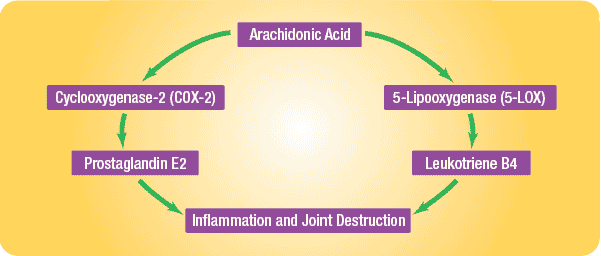Why Aging People Suffer From So Many Aching Joints

Aging too often results in the breakdown of healthy joint function and structure. Increasing evidence points to destructive inflammatory factors as culprits behind the joint problems humans encounter as they grow older.
While anti-inflammatory drugs have become mainstays in the medicine cabinets of senior citizens, an increasing body of knowledge reveals that natural approaches to maintaining joint health may be more effective, and a lot safer.
A review of the published scientific literature reveals significant anti-inflammatory effects when natural agents are used in human clinical studies. Yet, the lack of patent protection means these supplements will not be heavily advertised.
One benefit of natural agents is that they cost a lot less than prescription drugs. Another advantage to natural agents (such as fish oil) is their side benefits, as opposed to drug-induced side effects.
Pro-Inflammatory Cytokines
Two dangerous factors involved in joint damage are the pro-inflammatory cytokines interleukin-1b (IL-1b) and tumor necrosis factor-alpha (TNF-a). These inflammatory cytokines are normal, natural constituents of the body, but sometimes it is necessary to modulate their levels to avert damage. Cytokines are proteins that carry messages between cells and regulate immunity and inflammation. When they are elevated, pro-inflammatory cytokines inflict damage throughout the body.
Tumor necrosis factor-alpha and interleukin-1b play a pathological role in the cartilage destruction and inflammation process.1 These pro-inflammatory cytokines have been found in elevated levels in the synovial membrane, synovial fluid, and the cartilage of aging bones. In animal models, it was shown that inhibition of TNF-a results in decreased inflammation, while inhibition of IL-1 beta effectively prevents cartilage destruction.
Pro-Inflammatory Hormone-Like Substances
Another joint destroying mechanism involves the production of destructive hormone-like substances known as prostaglandin E2 and leukotriene B4. These inflammatory-inducing agents are synthesized from arachidonic acid by the enzymes cylooxygenase-2 (COX-2) and 5-lipooxygenase (5-LOX).
Aspirin and other non-steroidal anti-inflammatory drugs, long the mainstays of arthritis treatment, block both COX-1 and COX-2 enzymes. The COX-2 enzyme produces prostaglandin E2, which is a powerful trigger of pain and inflammation. However, COX-1 is necessary to protect the stomach lining, so interfering with its activity too much can cause gastric disturbances ranging from discomfort to bleeding ulcers. To reduce the risk of gastric problems, an increasing number of individuals are taking COX-2 inhibiting drugs.
The downside of only inhibiting the COX-2 enzyme is that an imbalance can occur during inflammation between the various end-products of arachidonic acid. When only COX-2 is blocked, more arachidonic acid is available to create leukotriene B4 (a dangerous pro-inflammatory agent). During inflammatory conditions, COX-2 and arachidonic acid levels rise dramatically and together.
When inhibiting only the COX-2 enzyme, levels of destructive leukotriene B4 can be raised via the 5-lipooxygenase pathway. This happens when arachidonic acid is blocked (via inhibition of COX-2) from converting into prosta-glandin E2. Instead, excess arachidonic acid may be converted (by 5-lipoxygenase) to leukotriene B4. The damaging effects of leukotriene B4 to the arterial wall and joint are well established.
So as this article was going to press, it is not surprising to learn that Vioxx® (a COX-2 inhibiting drug) was removed from the market because people who took it were having more heart attacks and strokes. The October 21, 2004 issue of The New England Journal of Medicine published highly critical articles on the failure of the FDA to remove Vioxx® sooner.
To better understand the pathways by which arachidonic acid can cause arthritic and cardiovascular conditions, the flow chart on next page shows how arachidonic acid cascades down into joint destructive compounds.
When levels of prostaglandin E2 or leukotriene B4 increase, this in turn raises levels of the pro-inflammatory cytokines TNF-alpha and IL-1 beta.3
Thus, COX-2 inhibition may help perpetuate the underlying degenerative process of arthritis while relieving its superficial symptoms. As the scientists who made this discovery put it, “the short-term effects of (COX-2 inhibitors) on the pain and swelling of inflammation and arthritis may be achieved at the cost of an increased propensity to long-term tissue damage with which these cytokines have been associated.”4
This research highlights the importance of inhibiting TNF-a and IL-1b, along with COX-2 and 5-lipooxygenase when seeking a comprehensive solution to chronic joint problems.
 |
Why Fish Oil is So Important
Since arachidonic acid is the precursor to joint destroying prostaglandin E2 and leukotriene B4 (refer to flow chart above), taking steps to reduce arachidonic acid is an important part of a joint protection program. Red meat is high in arachidonic acid, while cold-water fish contain oils that inhibit arachidonic acid formation in the body.
In one study, fish oil supplements given to rheumatoid arthritis patients reduced arachidonic acid levels by 33% compared to pre-treatment values.5 Another human study showed fish oil lowers arachidonic acid levels by 26%.6
Fish oil also suppresses the joint-tissue destructive TNF-a and IL-1b cytokines, which helps explain why so many published studies demonstrate the benefits of fish oil.7-13 Studies comparing healthy volunteers with rheumatoid arthritis patients show that fish oil supplementation inhibits production of the pro-inflammatory cytokines, TNF-a and IL-1b by as much as 90%!14
As mentioned already, another pro-inflammatory metabolite of arachidonic acid is leukotriene B4. COX-2 inhibitors do not suppress leukotriene B4, which helps explain why COX-2 inhibitors usually provide only partial relief from arthritis symptoms. Fish oil, on the other hand, suppresses both leukotriene B4 and prostaglandin E2.15-18
New Way to Suppress Inflammatory Cytokines and Hormones
Flavonoids are natural compounds found in a wide variety of fruits and vegetables. Bioflavonoids from citrus fruits such as oranges, tangerines, and grapefruit have been found to exert anti-inflammatory effects.19-20
The bioflavonoid nobiletin was first isolated from orange peel in 1938. Nobiletin has been shown to be a powerful anti-inflammatory agent.21-23 Early studies revealed that nobiletin significantly inhibits production of nitric oxide and superoxide, two powerful free radicals involved in promoting inflammation. In one study, nobiletin was shown to suppress several stages of skin inflammation.24
The flavonoid nobiletin has been found to selectively down-regulate COX-2 without interfering with COX-1.25 In mouse macrophages, nobiletin was also shown to suppress production of prostaglandin E2 while interfering with pro-inflammatory cytokines such as interleukin-1 beta, tumor necrosis factor-alpha, and interleukin-6.26
In addition, nobiletin demonstrated great anti-inflammatory activity.27 Through its effects in reducing inflammation, nobiletin may help to protect against a host of age-related problems including joint discomfort, cardiovascular problems and other inflammatory-induced disorders.
Glucosamine for Joint Structure
Glucosamine is a naturally occurring substance in the body, synthesized by chondrocytes for the purpose of producing joint cartilage. In patients with joint discomfort and degeneration, this synthesis is defective, and supplementation with glucosamine has been found to be beneficial.
The body uses supplemental glucosamine to synthesize the proteoglycans and the water-binding glycosaminoglycans in the cartilage matrix. In addition to providing building materials, the presence of glucosamine seems to stimulate the chondrocytes to produce these substances. Glucosamine also inhibits certain enzymes that destroy cartilage, including collagenase and phospholipase. By blocking pathogenic mechanisms that lead to joint degeneration, glucosamine protects and maintains healthy joints and relieves symptoms even for weeks after termination of treatment.28
Glucosamine is becoming recognized as a treatment for those seeking to protect and maintain healthy joints in the United States. Its ability to repair and improve joint function in addition to providing pain relief gives it a significant advantage over conventional treatment. Additionally, glucosamine may stimulate new tissue growth and suppresses the enzymes that otherwise break down cartilage.
Methylsulfonyl-methane (MSM): Sulfur for the Joints
Methylsulfonylmethane, also known as MSM, is a naturally occurring, organic sulfur compound found in human diets and those of virtually all other vertebrates. MSM occurs naturally in the human body as a result of the foods we eat. In vertebrates, the concentration of MSM in the body decreases with age. Some research suggests there is a minimum concentration of MSM that must be maintained in the body to preserve normal function and structure.
In experiments using radioactive-labeled sulfur, it was shown that after ingestion, MSM gives up its sulfur to the essential amino acids methionine, cysteine, and other serum proteins, eventually finding its way into the collagen of skin, joints, and blood vessels. It is also incorporated into the keratin of hair and nails.
Animal studies have shown that joints affected by osteoarthritis have lower sulfur content,29 and that arthritic mice given MSM experience less joint degeneration.30 In a double-blind trial in people with osteoarthritis, study participants who received MSM experienced significant pain relief.31 MSM is known to be very safe and non-toxic.
What Happens When Glucosamine and MSM Are Taken Together?
In an exciting new study, the combination of glucosamine with methylsulfonylmethane (MSM) was found to be more effective in the maintenance and protection of joints and bones than either agent alone.32
Glucosamine is known as a chondroprotective agent since it helps to protect and restore joint cartilage. MSM is known as an effective natural lubricant that promotes comfort. We now know that the combination of the two is even more powerful than each individual compound.
In this study, 118 patients with mild to moderate joint discomfort were treated three times daily for 12 weeks with either 500 mg of glucosamine, 500 mg MSM, a combination of both, or an inactive placebo. The patients were evaluated at 0, 2, 4, 8, and 12 weeks. The study evaluated patients’ pain, inflammation, and swelling.
Glucosamine, MSM, and the combination of glucosamine and MSM improved the pain and swelling compared with placebo. After 12 weeks of treatment, the average pain score in the glucosamine-only group dropped from 1.74 to 0.65…a 63% reduction. In the MSM-only group, it fell from 1.53 to 0.74...a 52% reduction. However, in the group taking glucosamine and MSM, the average pain score dropped from 1.7 to 0.36…an astounding reduction of 79%! The researchers also found that the combination therapy had a faster effect on pain and inflammation than either glucosamine or MSM alone.
The authors of the study concluded that the combination of glucosamine with MSM (methylsulfonylmethane) provides better and more rapid improvement in patients with osteoarthritis than either agent alone.
Summary
Arthritis and aging go hand in hand. Arthritis is not a single disease, but rather a host of conditions that adversely affect the joints.
Osteoarthritis is the most common form of arthritis, affecting approximately 70-80% of the population over age 50. Osteoarthritis occurs when the linings of joints degenerate, leading to lipping and spurring of the bone. This causes the symptoms of morning stiffness, crackling joints, and pain. Osteoarthritis most commonly affects the hips, knees, fingers, and spine, although other joints may also be involved. As the condition progresses, osteoarthritis leads to discomfort, pain, and varying degrees of disability for tens of millions of Americans.
Just as arthritis is not one condition, no single treatment is likely to yield a complete solution. A systemic approach targeting pro-inflammatory cytokines (such as IL-1b), the pro-inflammatory hormone-like substances (such as leukotriene B4), and cartilage structural destruction should more effectively address the multifaceted nature of the conditions that are known as arthritis.
New research is shedding light on how osteoarthritis develops at the cellular and molecular levels. Fish oil should be included in every aged person’s daily regimen for its cardio-protective effects, in addition to its ability to neutralize many different types of inflammatory reactions that lead to loss of joint function and structure. As we have learned in this article, there are additional natural agents, such as nobiletin, glucosamine, and MSM that combat the processes that cause so much suffering as humans age.


Social Login